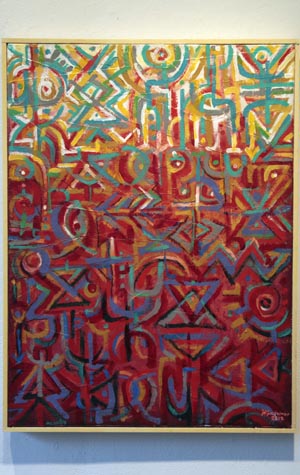Reviving an Ancient Script
Moroccan artist documents struggle for cultural survival

Moroccan artist Hamid Kachmar can’t recall a time when he wasn’t drawing and painting. Born into a family of indigenous Berber ancestry, Kachmar uses the symbols and colors of his African heritage to tell the story of his people’s struggle for cultural and linguistic recognition.
Kachmar was 13 when he discovered that his Amazigh Berber language had a script of its own. That ancient script—called Tifinagh—had been politically suppressed for centuries. As recently as the 1950s and 1960s, postcolonial nations, including Morocco, Algeria, Tunisia, and Libya, had refused to acknowledge Tamazight, the spoken language tied to Tifinagh script. For self-proclaimed cultural activist Kachmar, Tifinagh symbolizes not only cultural suppression, but the struggle to hold onto and celebrate cultural identity.
Kachmar has been incorporating Tifinagh script into his work for two decades, using it as a way to help revive and celebrate his Amazigh heritage. In his paintings and mixed works, he renders the script into visual compositions that tell the story of a struggle for identity.
“I want people to know that there’s another dimension to Moroccan culture,” Kachmar says, “because what is promoted, what people know as Morocco, is more like a Middle Eastern country, where there is the hookah, the shisha, and belly dancing.”
In the Sherman Gallery’s new show, Hamid Kachmar: Reviving the Ancient Tifinagh Script, on view through October 20, visitors can see for themselves how Kachmar uses art to evoke the story of a culture indigenous to North Africa and the Sahara. The work is divided into three sections, “Land,” “Language,” and “People,” some decidedly political, some deeply personal.
Presented as part of the 60th anniversary celebration of BU’s African Studies Center, the exhibition is curated by Cynthia Becker, a College of Arts & Sciences associate professor of art history. “It’s interesting because we can see this historic struggle of people, and it’s very timely given the Arab Spring,” Becker says.
Among the show’s 19 pieces, one of the most striking is a mixed media work titled Totem I. The title refers to the piles of stones that the Amazigh people used to mark important places—such as where a person died or where an important ceremony was to take place. The use of goatskin, bark cloth, and other unconventional materials gives the piece a wonderful three-dimensional quality.

In Symbols in Symbiosis II, Kachmar fills the canvas with abstract calligraphic symbols based on Tifinagh script and Amazigh motifs. In Africanium, the artist presents what he says is his vision of the Amazigh cosmos. The colors refer to the sun, land, and water. He incorporates Tifinagh script and weaves in imagery from other parts of the African continent and images inspired by Saharan cave paintings and Amharic script. The circular canvas is meant to emphasize the unity of the Amazigh people and to underscore their link to the African continent, says Kachmar, not to the Middle East.
Kachmar’s “work not only touches on identity and complex cultures, but also interprets the ancient Tifinagh script in visual terms that are more contemporary than historical,” says School of Visual Arts exhibitions director Lynne Cooney (GRS’08,’15). “His sense of color and composition is complex, while also evoking a sense of dense calm. His melding of old and new is evocative, enhanced by his color use.”
The palette in many of the works here recalls the desert region of southeastern Morocco, where Kachmar grew up. “He pulls a lot from the earth tones of that region,” Becker says, “and he uses a lot of natural pigments, such as henna, saffron, and indigo blue.”

Some of the work is decidedly more biographical and intimate. Shield pays homage to the influence of weaving in Amazigh culture. Kachmar’s mother was a weaver of Amazigh carpets and many of the motifs she used are similar to those found in Tifinagh script. Another work, Fissures & Ficelles, “Cracks and String,” is a visual exploration of Kachmar’s own experience as a Moroccan immigrant living in the United States and the pull his Amazigh ancestry continues to exert on him. (He earned an MFA from Howard University in 2006 and is now a lecturer there).
Some of the last work in the show celebrates the official recognition of the Amazigh language and culture, which occurred in 2011 after decades of pressure by activists. The palette in these paintings is noticeably brighter. The bold color in Tamghra (Festive), celebrates Tamazight’s recognition as an official language. The symbols, inspired by Tifinagh, appear to be floating in space. Kachmar’s use of color and movement here ends the show on a decidedly celebratory note.
Hamid Kachmar: Reviving the Ancient Tifinagh Script is at the Sherman Gallery, George Sherman Union, 775 Commonwealth Ave., second floor, through Sunday, October 20. The gallery is open Tuesday through Friday, from 11 a.m. to 5 p.m., and Saturday and Sunday, from 1 to 5 p.m.; phone: 617-358-0295. The exhibition is free and open to the public.
Sonia Su can be reached at ssu@bu.edu; follow her on Twitter at @SoniaSu_.
Comments & Discussion
Boston University moderates comments to facilitate an informed, substantive, civil conversation. Abusive, profane, self-promotional, misleading, incoherent or off-topic comments will be rejected. Moderators are staffed during regular business hours (EST) and can only accept comments written in English. Statistics or facts must include a citation or a link to the citation.